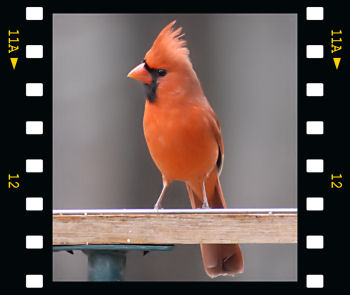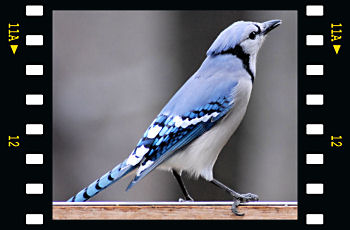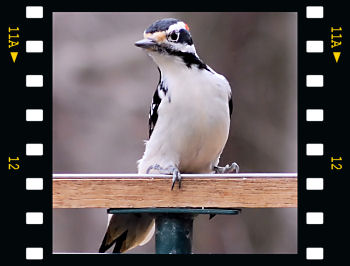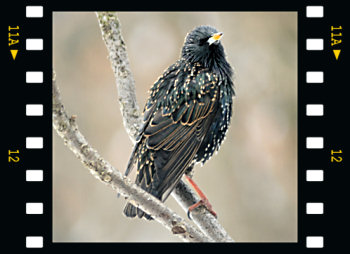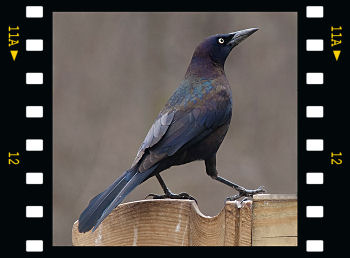
Large, crested finch with vivid red body. Black mask and chin contrast with heavy, red bill. Forages on ground and in trees and bushes. Feeds on seeds, grains, fruits, insects and snails. Hops instead of walks on ground. Alternates rapid wing beats with wings pulled to sides.
Interesting Facts
• The Northern Cardinal can live up to 15 years in the wild.
• Males that have a brighter red color appear to feed at higher rates and have greater reproductive success than males that are duller in color.
• A group of cardinals has many collective nouns, including "a college of cardinals", "a conclave of cardinals", "a deck of cardinals", "a radiance of cardinals", and a "Vatican of cardinals."
Medium woodpecker, black-barred gray-brown back, white rump, black tail. Underparts are black-spotted pale brown with black crescent on breast. Face is tan with gray crown, forehead, nape has a small red patch. Legs, feet are gray. There is a Red-shafted and a Yellow-shafted race.
Interesting Facts
• Although it can climb up the trunks of trees and hammer on wood like other woodpeckers, the Northern Flicker prefers to find food on the ground. Ants are its favorite food, and the flicker digs in the dirt to find them. It uses its long barbed tongue to lap up the ants.
• A group of flickers are collectively known as "a guttering of flickers", "a menorah of flickers", and a "Peterson of flickers."
Medium, noisy jay with bright blue upperparts, pale gray underparts,
distinct head crest, and neck surrounded with a curious black necklace. Black-barred wings and tail have prominent white patches. Direct flight with steady and buoyant wing beats. Glides between perches or to the ground.
Interesting Facts
• The Blue Jay's coloration is not derived by pigments, but is the result of light refraction due to the internal structure of the feathers; if a Blue Jay feather is crushed, the blue disappears as the structure is destroyed.
• They will prey on eggs and nestlings of other birds’ nests.
• Captive jays have been observed using tools and strips of newspaper to rake in food pellets from outside their cages.
• A group of jays has many collective nouns, including "a band of jays", "a cast of jays", "a party of jays", and a "scold of jays."
The largest titmouse, it has gray upperparts, pale gray underparts, rust-brown flanks. Head has dark gray cap crest, pale gray face, and white eye-ring. Bill is black. Wings and tail are gray. Legs and feet are gray. Most spend their entire lives not far from their birthplace.
Interesting Facts
• Unlike many chickadees, Tufted Titmouse pairs do not join larger flocks outside of the breeding season. Instead, most remain on the territory as a pair. Frequently one of their young from that year remains with them, and occasionally other juveniles from other places will join them. Rarely a young titmouse remains with its parents into the breeding season and will help them raise the next year's brood.
• Beginning in the 1940s, the Tufted Titmouse began expanding its range northward. Previous to that it was found only as far north as Iowa, Ohio, southern Pennsylvania, and New Jersey.
Medium-sized dove with gray-brown upperparts and pink-brown underparts. Eyes are dark with a small, black spot beneath. Bill is dark. Wings are gray-brown with black spots and dark primaries. Tail is long and pointed with black-edged white tips on outer feathers. Swift direct flight.
Interesting Facts
• A group of doves has many collective nouns, including "a bevy of doves", "cote of doves", "dole of doves", "dule of doves", and a "flight of doves."
Small woodpecker with black-and-white upperparts, white underparts. Head has red hindcrown patch. Face is white with black stripes.Tail is black with white outer tail feathers. Northwest birds have gray-brown breast, belly, and Bill is long and black. Legs and feet are black.
Interesting Facts
• The Hairy Woodpecker has more than 17 recognized subspecies.• They are the most prolific woodpeckers in North America.
• The males incubate the eggs during the night while the females incubate them during the day.
• A group of woodpeckers has many collective nouns, including "a descent of woodpeckers", "a drumming of woodpeckers", and a "gatling of woodpeckers."
Medium-sized, stocky sparrow with black-streaked brown upperparts and pale gray underparts. Wings are brown with single white bar. Cheeks and crown are pale gray, contrasting with black throat, upper breast, and bill. Legs are shorter and black bill is thicker than in native sparrows.
Interesting Facts
• The House Sparrow was introduced into Brooklyn, New York, in 1851. By 1900 it had spread to the Rocky Mountains. Its spread throughout the West was aided by additional introductions in San Francisco, California, and Salt Lake City, Utah.
• It is a frequent dust bather. It throws soil and dust over its body feathers, just as if it were bathing with water.

Like many members of the family Sciuridae, the eastern gray squirrel is a scatter-hoarder; it hoards food in numerous small caches for later recovery. Some caches are quite temporary, especially those made near the site of a sudden abundance of food which can be retrieved within hours or days for re-burial in a more secure site. Others are more permanent and are not retrieved until months later. It has been estimated that each squirrel makes several thousand caches each season. The squirrels have very accurate spatial memory for the locations of these caches, and use distant and nearby landmarks to retrieve them. Olfaction is used once the squirrel is within a few centimeters of the cache.
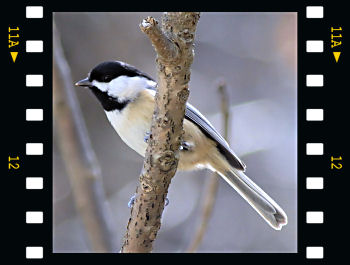
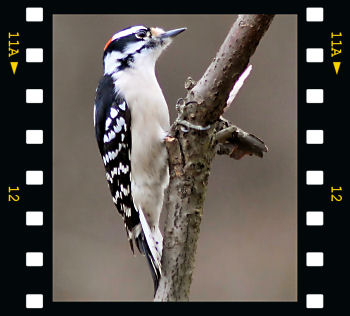
Medium-sized, stocky chickadee with pale gray upperparts and breast and pale olive-brown underparts.cap and bib and white cheeks are conspicuous. Black bill is short and thin. Wings are dark with broad white edges on feathers. State bird of Maine and Massachusetts.
Interesting Facts
• The Black-Capped Chickadee hides seeds and other food items for later recovery. Each item is placed in a different spot and a bird can remember thousands of hiding places.
• The chickadee's simple-sounding calls have been found to be extremely complex and language-like. They code information on identity and recognition of other flocks as well as predator alarms and contact calls.
The smallest woodpecker in North America. Has a white back, black nape and black wings with white spotting. Underparts are white. Face is white with black stripes. Hindcrown patch is red. Tail is black with black-spotted or barred white outer tail feathers. Bill is black and short.
Interesting Facts
• Males tend to feed in the tops of trees on branches that are smaller in diameter, whereas females feed in midlevel and lower sections of the tree on branches that are larger in diameter. Males aggressively maintain this segregation by chasing away any bird that attempts to feed near them.
• The Downy Woodpecker uses sources of food that larger woodpeckers cannot, such as the insect fauna on weed stems.
• As the smallest North American woodpecker, the Downy can drill cavities in dead trees or limbs that measure as little as 10 cm around. This means that it can live in a wider range of habitat than can larger woodpeckers.
• A group of woodpeckers has many collective nouns, including "a descent of woodpeckers", "a drumming of woodpeckers", and a "gatling of woodpeckers."

Medium-sized wren with rufous upperparts and buff underparts. Eyebrows are vivid white and the wings and tail are dark barred with white flecks. The throat, chin and upper breast are white. Bill is long and decurved. Legs and feet are pink-gray. It is the state bird of South Carolina.
Interesting Facts
• The Carolina Wren is sensitive to cold weather, with the northern populations decreasing markedly after severe winters. The gradually increasing winter temperatures over the last century may have been responsible for the northward range expansion seen in the mid-1900s.
• Unlike other wren species in its genus, only the male Carolina Wren sings the loud song. In other species, such as the Stripe-breasted Wren of Central America, both members of a pair sing together. The male and female sing different parts, and usually interweave their songs such that they sound like a single bird singing.
• One captive male Carolina Wren sang nearly 3,000 times in a single day.
• A pair bond may form between a male and a female at any time of the year, and the pair will stay together for life. Members of a pair stay together on their territory year-round, and forage and move around the territory together.

Large nuthatch, blue-gray upperparts, black crown and nape, and white face, underparts. Tail is dark with white corners. Legs and feet are black. Eats spiders,insects, nuts and seeds. Weak fluttering flight, alternates rapid wing beats with periods of wings drawn to sides.
Interesting Facts
• The White-breasted Nuthatch is normally territorial throughout the year, with pairs staying together. The male is more vigilant when he forages alone than when he is with the female. The female, however, is in danger of having the more dominant male displace her from foraging sites, and she is more vigilant when he is around than when she is alone.
• In winter, the White-breasted Nuthatch joins foraging flocks led by chickadees or titmice. One explanation for these flocks is that the birds gain protection from predators by the vigilance of the other birds. In support of this idea, one study found that if titmice were removed from a flock, nuthatches were more wary and reluctant to come to exposed bird feeders.
Medium sparrow with considerable geographic color variation, although all exhibit a pink bill, dark eyes, white belly, dark-centered tail with white outer feathers. Short flight with white outer tail feathers flashing, alternates several rapid wing beats with wings pulled to sides.
Interesting Facts
• Dark-eyed juncos are also called snowbirds because they suddenly appear during winter in areas where winter feeding stations can be found. In fact dark-eyed juncos are the most common birds to be found in bird feeders during winter in the entire North America.
• They like to feed on the ground, hopping around to search for seeds or insects.
• During winter male dark-eyed juncos go farther north than females and younger males go even farther north the older males. It is said that the males do this to get back to the breeding ground and claim their territories. Since females do not claim territories like the males do, they do no not need to winter as far north as the males do.
Small, chunky, iridescent purple and green blackbird with long, pointed yellow bill, pink legs, and short tail. The feathers on back and undertail show buff edges. Feeds in open areas, normally on the ground. Strong, direct and swift flight on rapidly beating wings.
Interesting Facts
• All of the 200 million European Starlings found in North America today are descendants of approximately 100 birds released in New York City's Central Park in the early 1890s by an industrialist who wanted to establish, in the U.S., all birds mentioned in the works of Shakespeare.
• Flocks are also noted for forming a tight sphere-like formation in flight, then expanding, contracting, whirling and even changing shape, all seemingly without any sort of leader, much as a school of fish. These displays sometime involve thousands of birds and are very spectacular.
• They compete aggressively for nesting sites and may evict the occupants of desired holes, including the woodpeckers that excavated them.
• An individual bird can mimic up to 20 species, including Eastern Wood Pewee, Killdeer, and Meadowlark songs.
• A group of starlings has many collective nouns, including "a constellation of starlings", "a filth of starlings", "a murmuration of starlings", "a scourge of starlings", and a "vulgarity of starlings."
Small, noisy finch. Male has a bright yellow body, black cap, wings, and tail, and white rump and undertail coverts. Wings have flashy white patches and bright yellow shoulder bar. Bill is conical. Undulating flight, alternates several rapid wing beats with wings pulled to sides.
Interesting Facts
• The American Goldfinch changes from winter plumage to breeding plumage by a complete molt of its body feathers. It is the only member of its family to have this second molt in the spring; all the other species have just one molt each year in the fall.
• They are one of the latest nesting birds, starting in late June or early July, when most other songbirds are finishing with breeding. Their late timing may be related to the availability of suitable nesting materials and seeds for feeding young.
• Brown-headed Cowbirds may lay an egg in a Goldfinch nest, but the hatchling will usually die because the seed-based diet that the parents provide cannot support it.
• A group of goldfinches has many collective nouns, including a " 007", "charm", "rush", "treasury", and "vein" of goldfinches.
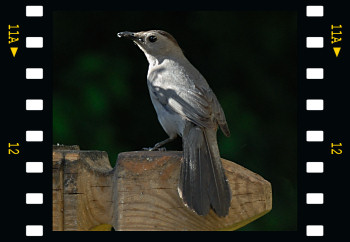 Gray Catbird
Gray Catbird 
Small, shy, dark gray mockingbird with black cap and red-brown undertail coverts. Bill, legs, and feet are black. Sexes are similar. Juvenile is gray-brown above with slate-gray crown.
Interesting Facts
• Gray Catbirds are able to recognize their own eggs making them less susceptible to brood parasites such as the Brown-headed Cowbird.
• When feeding on the ground, they toss leaves aside with their bills rather than scratching with their feet.
• Their calls include the catlike meow call that gives them their name.
• A group of catbirds are collectively known as a "mewing" and a "seat" of catbirds.
Medium-sized blackbird with metallic purple sheen on back, head, neck, and breast. Eyes are bright yellow. Central feathers of long, rounded tail are often lowered to show keeled V-shape. Female is smaller and duller. Juvenile is dark brown with dark eyes.
Interesting Facts
• Grackles actually walk instead of hop.
• In coastal areas they forage at the tide line for small invertebrates, even wading
into the water to capture live fish.
• Adults sometimes function as helpers to other birds of the species.
• They allow ants to crawl on their bodies and secrete formic acid, possibly to rid themselves of parasites.

